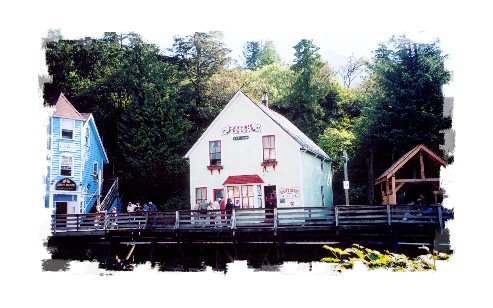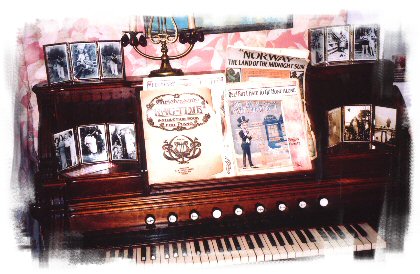 |
|||
 |
|||
 |
|||
 |
|||
 |
|||
 |
|||

by Patricia M. Lee
 at House and Sporting
Women were familiar words bandied about in the early 1800s when describing
the red-light district in Ketchikan, Alaska. The town, known as the salmon
capital of the world, is usually the first port of call for cruise ships traveling
north. Originally it was a fishing camp settled by the Klinget Indians who
named it Kitch-Kan, meaning “the thundering wings of an eagle.”
The area was shaped just like an eagle in flight.
at House and Sporting
Women were familiar words bandied about in the early 1800s when describing
the red-light district in Ketchikan, Alaska. The town, known as the salmon
capital of the world, is usually the first port of call for cruise ships traveling
north. Originally it was a fishing camp settled by the Klinget Indians who
named it Kitch-Kan, meaning “the thundering wings of an eagle.”
The area was shaped just like an eagle in flight.
Dolly’s House is one of the most frequented sights and one of the few remaining structures left in the district. During the l800s, speakeasies and dance halls grew, as well as a string of small wooden peaked roof houses built on pilings along a boardwalk above the creek. Dolly’s House stood out among the others. Men were enticed by the house’s porch-lighted globes beaming on girl’s names such as Frenchie, Prairie Chicken and Deep Water Mary. The town was said to be the only place in the world where the fishermen went up the stream to spawn.
…
a house is not a home, but Dolly considered hers a real home, and lived there
until her death.
Dolly was born Thelma Dolly Copeland in 1888 in McCall, Idaho. She left home
at 13, worked as a waitress in Seattle and Spokane, and then moved to Vancouver.
At 18, she realized selling her favors was a much more lucrative way to earn
money. She plied her trade for awhile until she heard about the salmon fisheries
in Ketchikan. She liked it there, she said, because the men came in bunches.
She moved to the town, changed her name to Dolly Arthur, and after a stint working in the Star Dance Hall, opened her own house in 1919. It was known as the House of Pleasure. At that time it was all right for two girls to live together in a house but more than two girls made it a house of prostitution.
Dolly chose to occupy the house alone after one girl left. The small house
consisted of two floors with a kitchen, living and dining room downstairs,
and bedrooms above. She had strict rules for her guests. No smoking, drinking
or swearing was allowed. She was a stickler for neatness and cleanliness.
Now a museum, the house features antiques, old photographs, secret caches,
and the history of its famous Madam, Dolly. A friendly guide dressed in a
colorful costume greeted us at the entrance, where a large piano with sheet
music of the times waited for a pianist. We browsed the downstairs rooms and
admired the interesting pictures, posters, and memorabilia in the living room.
The dining room contained a table set with dishes and silverware.
Upstairs, the main bedroom contained a four- poster bed with a silk quilted
bedspread, and some of Dolly’s dresses. The extra bedroom contained many
other treasures of the past. Stairs outside this room led to a secret path
where married men entered and left the establishment.
In 1954, the city counsel closed down the district. Cat Houses and Sporting Women no longer existed. Today, visitors walk along Creek Street, browse the shops, and visit Dolly’s House. Her house provides a glimpse of the notoriety of the red-light district in its heyday. It’s been said that a house is not a home, but Dolly considered hers a real home, and lived there until her death in 1975. Her final words were, “I’m going on a last trip.”
Ketchikan: tel. 800/770-3300;
www.visit-ketchikan.com
Return to: Current articles, Top, Home.
 Dolly's House
Dolly's House
Chuck Lee photo
 Dolly's
piano
Dolly's
piano
Patricia M. Lee photo